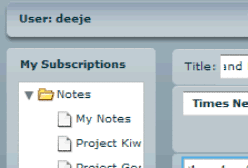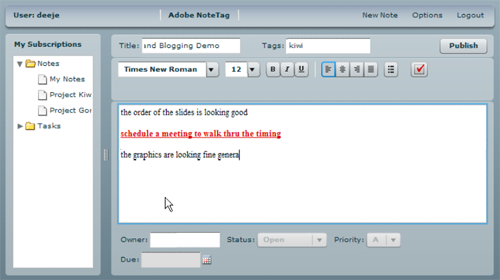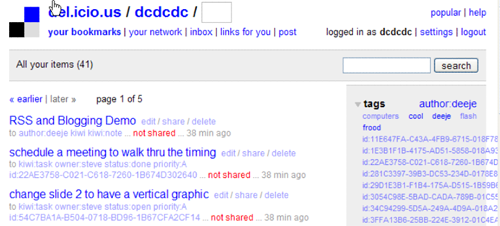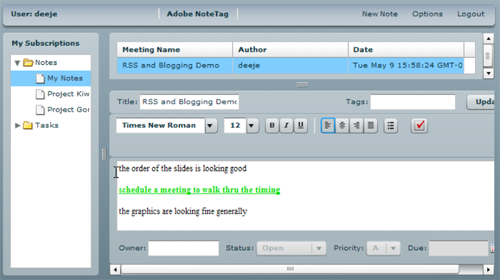This post was written by Ryan
Stewart, a Read/WriteWeb guest blogger. Note that Adobe’s use of the terms
‘Read/Write Web’ and ‘kiwi’ is not associated with this blog.
There is an interesting project going on over at Adobe that
aims to combine the power of Flex 2
with the potential of the Read/Write Web. The project is codenamed Kiwi and they have
already started showing how Flex 2 and the concept of a Read/Write Web can be combined to
create a fantastic experience and bring about innovative ideas for interacting with
data.

The Kiwi project was born out of Macromedia’s Contribute, which put
the web into the hands of normal people. You didn’t have to be a techie to publish on the
web – Contribute made it easy to manipulate a website and add your own content to it. The
idea was that website management could be done by anyone. When the Contribute team saw
the potential of Flex 2, they started thinking about ways to apply their knowledge of
interacting with content on the web to the world of Rich Internet Applications – and the
Kiwi project was born.
NoteTag – RSS + Flex 2

Their first major release is NoteTag, which was built as a
proof-of-concept to show the potential of RSS, Flex 2 and the Read/Write Web. Currently,
the application requires installation on a server – but the team assures me that a public
working version is on the way (they have a demo of the application in action here). NoteTag allows users
in a meeting to extract notes from the meeting and assign tasks from those notes to
individuals. NoteTag actually stores the notes as blog entries and the task data as microformats, using del.icio.us and Blogger/Typepad. It uses RSS data and the
open web services from del.icio.us to link tasks to specific notes. The NoteTag team
built an Atom Protocol library, a Tag Server Protocol library and what they call an
extended RSSRW (RSS Read/Write) library, which is what builds the RSS feed from
the note/task data.

More about Flex 2 and the Read/Write Web
The idea of combining Flex 2 and the Read/Write Web is one that has a lot of
potential. Because Flash is cross-platform and can run on a variety of devices, it isn’t
hard to imagine a Read/Write Web application being written for the web and then being
easily ported to mobile devices – so that you can interact and manipulate your data from
anywhere.
The Read/Write Web is powerful precisely because it takes the web and puts it into
manageable bits. If you think of the web as a river of data, then the ideal should be to
allow users to take parts of data from that river, interact with it, and then put them
back for others to see. Flex 2 provides the engine with which to deliver a rich user
experience, while manipulating that data. The data is the most important part, but if the
user experience is perfected then more and more people will be drawn into the mix and we
will all be better off. The river will get a lot bigger!

Conclusion: adding the Write component to RIAs
Putting a great experience on top of the Read/Write Web also opens up other verticals.
Imagine companies being able to actually engage with their customers instead of just
pushing ideas at them. With experience at the forefront, companies can be encouraged to
share more and their customers will be inclined to participate – eventually becoming
stakeholders in the brand and products. RIAs allow for an incredible level of branding,
that when combined with content, makes for an enticing place for customers to share
ideas. Currently you see high-experience flash websites for things like movies and cars,
but there is no “write” component to them. Take that branding, add the write component
and you will be able to engage with customers in revolutionary ways.
The Kiwi project aims to harness all of the potential of the Flex 2 experience and
show how beneficial incorporating the Read/Write Web can be. Taking the vast amounts of
data that exists on the web and providing a rich, cross-platform way to interact with it
could be a gigantic step towards bringing more people on board. Experience and engagement
can be an immense draw for the regular user.










